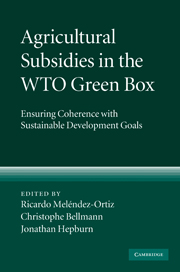Book contents
- Frontmatter
- Contents
- List of contributors
- Preface
- Acknowledgements
- List of abbreviations
- 1 Overview
- PART I The recent evolution of agricultural trade policy reform
- PART II The focus, extent and economic impact of green box subsidies
- PART III Green box subsidies and developing countries
- PART IV Green box subsidies and the environment
- PART V Looking forward: how can change take place?
- Appendix: Text of Annex 2 of the WTO Agreement on Agriculture (“the green box”)
- Index
Preface
Published online by Cambridge University Press: 03 May 2010
- Frontmatter
- Contents
- List of contributors
- Preface
- Acknowledgements
- List of abbreviations
- 1 Overview
- PART I The recent evolution of agricultural trade policy reform
- PART II The focus, extent and economic impact of green box subsidies
- PART III Green box subsidies and developing countries
- PART IV Green box subsidies and the environment
- PART V Looking forward: how can change take place?
- Appendix: Text of Annex 2 of the WTO Agreement on Agriculture (“the green box”)
- Index
Summary
Agriculture remains the main source of livelihood for more than 2.6 billion people in the world, the majority of whom are located in developing countries. Rising incomes, urbanization and shifting consumption patterns have increased food consumption in most areas of the world. However, despite spectacular increases in food production per capita, major distributional inequalities in access to food persist. In 2006, the proportion of children under five who are undernourished declined from 33 per cent in 1990 to 26 per cent in 2006, and more than 140 million children in developing countries were underweight – suggesting that governments may well miss the target of halving, between 1990 and 2015, the proportion of people who suffer from hunger.
At the same time, according to the Millennium Ecosystem Assessment, the prospect of providing sufficient food to sustain another 2 billion people by 2020 has rightly focused attention on the very real threats to food security if the productivity of agricultural systems cannot keep pace with this demand. As these systems are under increasing pressure to meet the growing need for food, it is also vital that the environmental challenges associated with food production are addressed effectively – water pollution, pesticide use, land degradation and greenhouse gas emissions, amongst others.
It is widely recognized that government policies are significant drivers of food production and consumption patterns, both locally and globally.
- Type
- Chapter
- Information
- Agricultural Subsidies in the WTO Green BoxEnsuring Coherence with Sustainable Development Goals, pp. xvii - xxiiPublisher: Cambridge University PressPrint publication year: 2009



